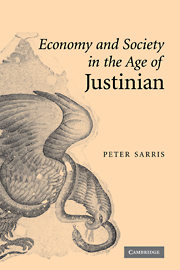Book contents
- Frontmatter
- Contents
- List of figures
- Preface
- Introduction
- 1 Egypt and the political economy of empire
- 2 The Apion archive: economic structure and estate accounts
- 3 Labour and administration: the evidence of the contractual papyri
- 4 Letters and petitions: social relations in the sixth-century Oxyrhynchite
- 5 The Apiones and their analogues
- 6 On the margins of magnate power: Dioscorus and Aphrodito
- 7 Landscapes of power: the great estate beyond Egypt
- 8 The historiography of the great estate
- 9 The great estate and the imperial authorities
- 10 The rise of the great estate
- 11 Economy and society in the age of Justinian
- Conclusion
- Bibliography
- Index
Introduction
Published online by Cambridge University Press: 24 July 2009
- Frontmatter
- Contents
- List of figures
- Preface
- Introduction
- 1 Egypt and the political economy of empire
- 2 The Apion archive: economic structure and estate accounts
- 3 Labour and administration: the evidence of the contractual papyri
- 4 Letters and petitions: social relations in the sixth-century Oxyrhynchite
- 5 The Apiones and their analogues
- 6 On the margins of magnate power: Dioscorus and Aphrodito
- 7 Landscapes of power: the great estate beyond Egypt
- 8 The historiography of the great estate
- 9 The great estate and the imperial authorities
- 10 The rise of the great estate
- 11 Economy and society in the age of Justinian
- Conclusion
- Bibliography
- Index
Summary
In the year 565, in the imperial capital of Constantinople, the Emperor Justinian died, bringing to a close a reign that had lasted some forty-eight years. In death, as in life, Justinian left a deep impression on those around him. The Latin court poet Corippus declared that ‘the awesome death of the man showed by clear signs that he had conquered the world. He alone, amidst universal lamentations, seemed to rejoice in his pious countenance.’ The memory of Justinian was to loom large in the minds of subsequent generations of emperors, just as the physical monuments built in Constantinople during his reign were long to dominate the medieval city. The emperor had reformed the civil law of the empire, overhauled its administrative structures, and restored imperial rule to Africa, Italy, and part of Spain; he had engaged in long drawn-out warfare with the prestige enemy of Sasanian Persia and attempted to restore peace to the increasingly fissile imperial Church. In short, through his military exertions, Justinian had done much to restore the Roman Empire to a position of military and ideological dominance in the lands bordering the central and western Mediterranean, whilst at home he had sought to bolster the legal, administrative, and religious authority of the imperial office.
This attempted restoration of imperial fortunes had been accompanied by a concerted effort to propagandise on behalf of the emperor and his policies.
- Type
- Chapter
- Information
- Economy and Society in the Age of Justinian , pp. 1 - 9Publisher: Cambridge University PressPrint publication year: 2006

